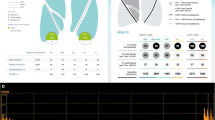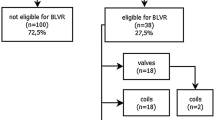Abstract
Introduction
The goal of our systematic review and meta-analysis is to examine the therapeutic effectiveness of bronchoscopic lung volume reduction (BLVR), and to compare it with medical management and lung volume reduction surgery.
Methods
Variables of interest were absolute change in FEV1, 6MWT, and SGRQ. Meta-analysis was performed for the BLVR modalities with ≥3 trials. Of the 18 shortlisted publications, only valves (four trials; n = 159) and coils (six trials; n = 194) qualified for meta-analysis. To avoid redundant reporting for valves, only the data for intact fissure subjects were analyzed. Outcome data are presented as the mean difference from baseline with 95% confidence interval at 6-months follow-up.
Results
For BLVR using valves, the pooled mean difference (PMD) for FEV1 was 0.146 L (95% CI 0.111–0.181; p < 0.001), 6MWT was 45.225 meters (95% CI 26.954–63.495; p < 0.001), and SGRQ was −8.825 points (95% CI −14.824 to −2.825; p = 0.004). All the PMDs were statistically significant and higher than their respective minimal clinically important difference (MCID). For BLVR using coils, the PMD for FEV1 was 0.080 L (95% CI 0.057–0.104; p < 0.001), 6MWT was 45.320 meters (95% CI 28.040–62.600; p < 0.001), and SGRQ was −10.570 points (95% CI −13.299 to −7.841; p < 0.001). All three variables showed statistically significant PMDs but that for FEV1 was smaller than the MCID. Data from BLVR modalities with <3 major publications are reviewed in the discussion section.
Conclusions
BLVR offers early promise in the palliation of advanced emphysema. Better characterization of patients to identify phenotypes that will derive sustained benefit is needed.

Similar content being viewed by others
References
Mathers BM, Degenhardt L, Phillips B et al (2008) Global epidemiology of injecting drug use and HIV among people who inject drugs: a systematic review. Lancet 372(9651):1733–1745
Mannino DM, Homa DM, Akinbami LJ et al (2002) Chronic obstructive pulmonary disease surveillance–United States, 1971–2000. Respir Care 47(10):1184–1199
Fishman A, Martinez F, Naunheim K et al (2003) A randomized trial comparing lung-volume-reduction surgery with medical therapy for severe emphysema. N Engl J Med 348(21):2059–2073
Ahmad S, Taneja A, Kurman J et al (2014) National trends in lung volume reduction surgery in the United States: 2000 to 2010. Chest 146(6):e228–e229
Moher D, Liberati A, Tetzlaff J et al (2009) Preferred reporting items for systematic reviews and meta-analyses: the PRISMA statement. J Clin Epidemiol 62(10):1006–1012
Sciurba FC, Ernst A, Herth FJ et al (2010) A randomized study of endobronchial valves for advanced emphysema. N Engl J Med 363(13):1233–1244
Herth FJ, Noppen M, Valipour A et al (2012) Efficacy predictors of lung volume reduction with Zephyr valves in a European cohort. Eur Respir J 39(6):1334–1342
Venuta F, Anile M, Diso D et al (2012) Long-term follow-up after bronchoscopic lung volume reduction in patients with emphysema. Eur Respir J 39(5):1084–1089
Donohue JF (2005) Minimal clinically important differences in COPD lung function. COPD 2(1):111–124
Puhan MA, Chandra D, Mosenifar Z et al (2011) The minimal important difference of exercise tests in severe COPD. Eur Respir J 37(4):784–790
Jones PW (2005) St. George’s respiratory questionnaire: MCID. COPD 2(1):75–79
Higgins JP, Altman DG, Gotzsche PC et al (2011) The Cochrane collaboration’s tool for assessing risk of bias in randomised trials. BMJ 343:d5928
Sciurba FC, Ernst A, Herth FJ et al (2010) A randomized study of endobronchial valves for advanced emphysema. N Engl J Med 363(13):1233–1244
Klooster K, ten Hacken NH, Hartman JE et al (2015) Endobronchial valves for emphysema without interlobar collateral ventilation. N Engl J Med 373(24):2325–2335
Deslee G, Klooster K, Hetzel M et al (2014) Lung volume reduction coil treatment for patients with severe emphysema: a European multicentre trial. Thorax 69(11):980–986
Deslee G, Mal H, Dutau H et al (2016) Lung volume reduction coil treatment vs usual care in patients with severe emphysema: the REVOLENS randomized clinical trial. JAMA 315(2):175–184
Klooster K, Ten Hacken NH, Franz I et al (2014) Lung volume reduction coil treatment in chronic obstructive pulmonary disease patients with homogeneous emphysema: a prospective feasibility trial. Respiration 88(2):116–125
Kontogianni K, Gerovasili V, Gompelmann D et al (2014) Effectiveness of endobronchial coil treatment for lung volume reduction in patients with severe heterogeneous emphysema and bilateral incomplete fissures: a six-month follow-up. Respiration 88(1):52–60
Slebos DJ, Klooster K, Ernst A et al (2012) Bronchoscopic lung volume reduction coil treatment of patients with severe heterogeneous emphysema. Chest 142(3):574–582
Zoumot Z, Kemp SV, Singh S et al (2015) Endobronchial coils for severe emphysema are effective up to 12 months following treatment: medium term and cross-over results from a randomised controlled trial. PLoS ONE 10(4):e0122656
Criner GJ, Pinto-Plata V, Strange C et al (2009) Biologic lung volume reduction in advanced upper lobe emphysema: phase 2 results. Am J Respir Crit Care Med 179(9):791–798
Herth FJ, Gompelmann D, Stanzel F et al (2011) Treatment of advanced emphysema with emphysematous lung sealant (AeriSeal(R)). Respiration 82(1):36–45
Kramer MR, Refaely Y, Maimon N et al (2013) Two-year follow-up in patients treated with emphysematous lung sealant for advanced emphysema. Chest 144(5):1677–1680
Refaely Y, Dransfield M, Kramer MR et al (2010) Biologic lung volume reduction therapy for advanced homogeneous emphysema. Eur Respir J 36(1):20–27
Herth FJ, Ernst A, Baker KM et al (2012) Characterization of outcomes 1 year after endoscopic thermal vapor ablation for patients with heterogeneous emphysema. Int J Chron Obstr Pulm Dis 7:397–405
Herth FJ, Valipour A, Shah PL et al (2016) Segmental volume reduction using thermal vapour ablation in patients with severe emphysema: 6-month results of the multicentre, parallel-group, open-label, randomised controlled STEP-UP trial. Lancet Respir Med 4(3):185–193
Song L, Zhao F, Ti X et al (2013) Bronchoscopic lung volume reduction for pulmonary emphysema: preliminary experience with endobronchial occluder. Respir Care 58(8):1351–1359
Shah P, Slebos D, Cardoso P et al (2011) Bronchoscopic lung-volume reduction with exhale airway stents for emphysema (EASE trial): randomised, sham-controlled, multicentre trial. Lancet 378(9795):997–1005
Springmeyer SC, Bolliger CT, Waddell TK et al (2009) Treatment of heterogeneous emphysema using the spiration IBV valves. Thorac Surg Clin 19(2):247–253
Venuta F, Anile M, Diso D et al (2012) Long-term follow-up after bronchoscopic lung volume reduction in patients with emphysema. Eur Respir J 39(5):1084–1089
Zoumot Z, Kemp SV, Singh S et al (2015) Endobronchial coils for severe emphysema are effective up to 12 months following treatment: medium term and cross-over results from a randomised controlled trial. PloS ONE 10(4):e0122656
Ninane V, Geltner C, Bezzi M et al (2012) Multicentre European study for the treatment of advanced emphysema with bronchial valves. Eur Respir J 39(6):1319–1325
Sciurba FC, Criner GJ, Strange C et al (2016) Effect of endobronchial coils vs usual care on exercise tolerance in patients with severe emphysema: the RENEW randomized clinical trial. JAMA 315(20):2178–2189
Come C, Abu-Hijleh M, Berkowitz D, Bezzi M et al (2014) Results of the ASPIRE endoscopic lung volume reduction trial at study termination. Eur Respir J 44(58):P3717
Iftikhar IH, McGuire FR, Musani AI (2014) Efficacy of bronchoscopic lung volume reduction: a meta-analysis. Int J Chron Obstr Pulm Dis 9:481–491
Slebos D-J, Hartman JE, Klooster K et al (2015) Bronchoscopic coil treatment for patients with severe emphysema: a meta-analysis. Respiration 90(2):136–145
Hopkinson NS, Kemp SV, Toma TP et al (2011) Atelectasis and survival after bronchoscopic lung volume reduction for COPD. Eur Respir J 37(6):1346–1351
Author Contributions
Both AK and MJM are equal contribution authors. AK conceptualized the study, prepared the search strategy, reviewed the abstracts and manuscripts for study selection, abstracted the data, performed the data analysis, and prepared the final manuscript. MJM supervised the search strategy, reviewed the abstracts and manuscripts for study selection, abstracted the data, assisted in data analysis, and edited the final manuscript. RD abstracted data for responder analysis, performed the risk of bias assessment, and contributed to manuscript revision. KS performed the data analysis and final manuscript review.
Author information
Authors and Affiliations
Corresponding author
Ethics declarations
Conflict of interest
The authors declare that there are no conflicts of interest or financial disclosures.
Ethical Approval
This research involves data extracted from already published literature and hence, no human or animal subjects were directly involved.
Informed consent
No informed consent was deemed necessary.
Electronic supplementary material
Below is the link to the electronic supplementary material.
Rights and permissions
About this article
Cite this article
Kumar, A., Dy, R., Singh, K. et al. Early Trends in Bronchoscopic Lung Volume Reduction: A Systematic Review and Meta-analysis of Efficacy Parameters. Lung 195, 19–28 (2017). https://doi.org/10.1007/s00408-016-9969-x
Received:
Accepted:
Published:
Issue Date:
DOI: https://doi.org/10.1007/s00408-016-9969-x




